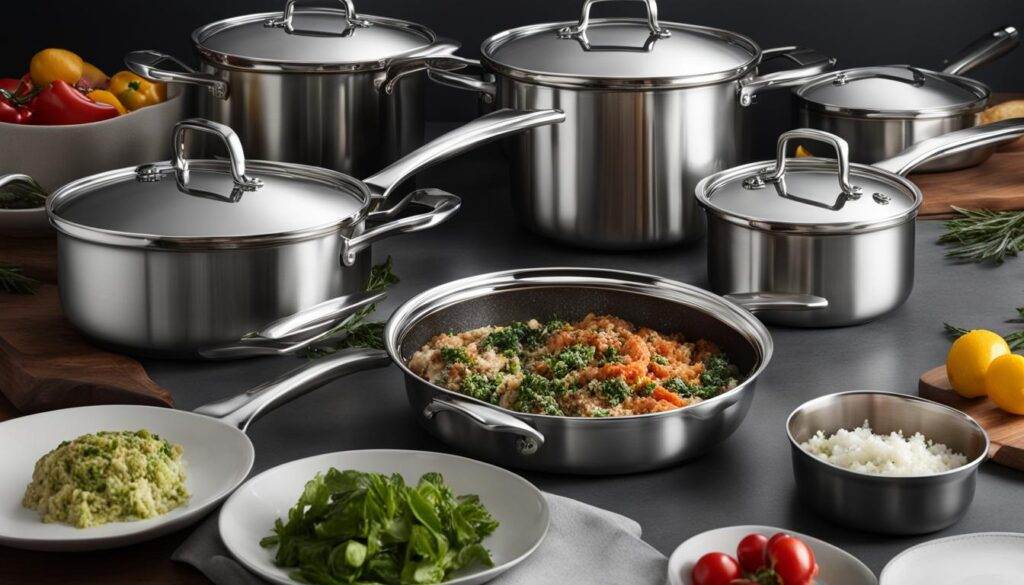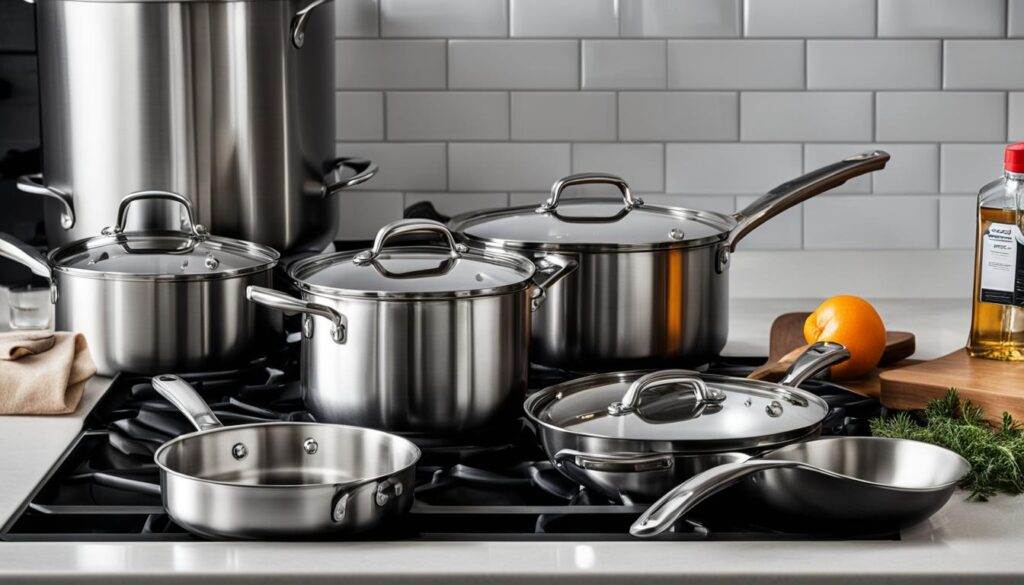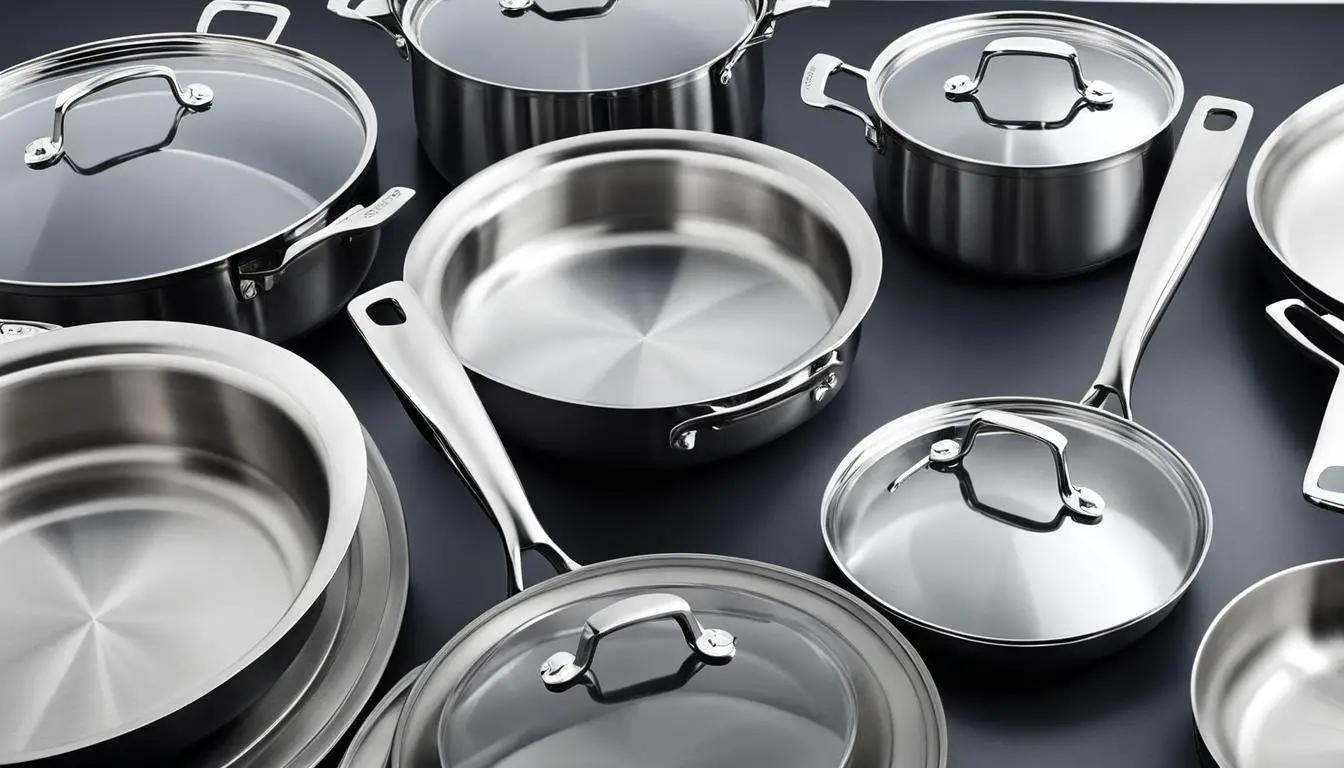Explore the ultimate guide to types of stainless steel for cookware, complete with professional chefs’ recommendations and essential tips. This must-read guide covers stainless steel pots and pans, cookware materials, and other kitchen essentials.
Types of Stainless Steel for Cookware
What is Stainless Steel?
Stainless steel is a metal made from iron, carbon, and at least 10.5% chromium. This mix gives it corrosion resistance, meaning it doesn’t rust easily. The chromium content forms a protective layer on the surface, making it durable and long-lasting. Some types also have nickel, which adds strength and shine.
Common Types of Stainless Steel for Cookware
There are several types of stainless steel used in cookware, each with unique properties.
18/10 Stainless Steel
18/10 stainless steel has 18% chromium and 10% nickel. It’s known for its great corrosion resistance and being non-reactive, so it won’t change the taste or color of food. It’s a top pick for high-quality cookware because it’s durable and shiny.
18/8 Stainless Steel
18/8 stainless steel contains 18% chromium and 8% nickel. It’s a bit cheaper than 18/10 but still offers good durability and efficient heat distribution, making it reliable for everyday cooking.
430 Stainless Steel
430 stainless steel has only chromium without any nickel, making it more affordable but less resistant to corrosion. However, it’s often used in budget-friendly cookware because it’s magnetic, which works well with induction cooktops.
304 Stainless Steel
One of the most common types used in kitchenware is 304 stainless steel, which includes both chromium and nickel. It offers excellent rust protection, making it ideal for various kitchen items like pots, pans, and utensils.
316 Stainless Steel
Containing molybdenum along with chromium and nickel, 316 stainless steel is highly resistant to acids found in foods like tomatoes or citrus fruits. This makes it perfect for cooking high-acid foods, ensuring longevity even under harsh conditions.
Choosing the Right Type of Stainless Steel for Your Needs
Factors to Consider: Budget
Your budget plays a big role when picking stainless steel cookware. Higher-end options like 18/10 or 316 may offer better durability but cost more. Affordable options like 430 provide good value without breaking the bank.
Intended Use
Think about how you plan to use your cookware. If you cook on an induction stove often, you’ll need magnetic-compatible options like those made from 430 stainless steel. If you often prepare acidic dishes, investing in high-quality options like 316 might be worth it.
Cleaning Habits
Your cleaning habits should also influence your choice. If you prefer easy-to-clean cookware that can withstand regular use without special care, look for types like 304 or higher-grade options that resist staining and rusting more effectively.
By understanding these different types of stainless steels and considering your specific needs—whether it’s budget constraints or cooking preferences—you can make an informed choice that ensures long-lasting satisfaction with your cookware investment.
Benefits of Using Stainless Steel Cookware
Durability and Longevity
Stainless steel cookware is known for being super tough and lasting a long time. It doesn’t rust or get messed up easily, so you can use it every day without worrying about it falling apart. This makes it a great buy for your kitchen. Stainless steel is strong and keeps working well for years.
Versatility
Stainless steel cookware is really versatile. You can use it on the stove, in the oven, or even on the grill. Whether you’re making sauces, cooking meats, or veggies, stainless steel pots and pans can handle it all.
Hygienic Properties
Stainless steel has awesome hygienic properties because its surface doesn’t let bacteria build up. This makes it safe for cooking since there’s less chance of germs getting into your food. Plus, stainless steel cookware is easy to clean and keep shiny.
Health Benefits
Using stainless steel cookware is good for your health because it doesn’t release harmful chemicals into your food. Unlike some other materials that might leak toxins when they get hot or scratched, stainless steel gives you a safe surface to cook on, helping you make healthier meals.

Enhancing Stainless Steel Cookware with Clad Construction
One way to enhance the performance of stainless steel cookware is through clad construction. This involves bonding layers of different metals together to combine their strengths.
Tri-Ply and Multi-Ply Construction
Tri-Ply Construction:
- Typically consists of an aluminum core sandwiched between layers of stainless steel.
- Combines the durability and non-reactivity of stainless steel with the excellent heat conductivity of aluminum.
- Ideal for even heating and reduced hot spots.
Multi-Ply Construction:
- Involves additional layers beyond the basic tri-ply construction, often adding more layers of aluminum or other metals.
- Further enhances heat distribution and cooking performance.
- Can be more expensive due to the added complexity and materials.
Choosing the Right Stainless Steel Cookware Set
When shopping for stainless steel cookware, consider the following tips:
1. Assess Your Cooking Style
- Determine the types of cooking you do most frequently. Do you need versatile pieces for various techniques, or specific items like a large stockpot or a small saucepan?
2. Evaluate the Set Composition
- Look for sets that include essential pieces such as skillets, saucepans, and stockpots. Ensure the sizes and shapes meet your cooking needs.
3. Check the Quality of Construction
- Opt for cookware with sturdy, well-attached handles and lids. Riveted handles are often more durable than welded or screwed-on handles.
- Inspect the weight of the cookware. Heavier pieces generally indicate better quality and durability.
4. Consider Compatibility with Your Cooktop
- Ensure the cookware is compatible with your cooktop, especially if you use an induction stove. Look for magnetic stainless steel if induction compatibility is required.
5. Look for Additional Features
- Some cookware sets come with additional features like measurement markings inside pots, pouring spouts, or strainer lids. These can add convenience to your cooking.

Tips for Cooking with Stainless Steel
Seasoning Your Cookware
Related Keywords: Seasoning, Stainless Steel Cookware, Non-Stick, Cooking Techniques, Food Release Stainless Steel
Seasoning stainless steel cookware helps create a semi-nonstick surface that improves food release and makes cleaning easier. To season your stainless steel pan, follow these steps:
- Clean the Pan: Wash the pan thoroughly with warm soapy water to remove any manufacturing residues.
- Dry Completely: Ensure the pan is completely dry before proceeding.
- Apply Oil: Pour a small amount of high-smoke-point oil (such as vegetable oil or canola oil) onto a paper towel and rub it over the entire interior surface of the pan.
- Heat the Pan: Place the oiled pan on medium heat until it begins to smoke slightly. Turn off the heat and let it cool completely.
- Wipe Excess Oil: Wipe out any excess oil with a clean paper towel.
Repeat this process periodically to maintain the seasoning layer.
Cooking Techniques
Related Keywords: Using Right Heat Settings, Avoiding Overheating, Preheating Too Quickly, Searing, Sautéing, High Heat Retention
Stainless steel cookware requires specific cooking techniques to achieve optimal results:
- Preheat Properly: Always preheat your stainless steel pans before adding food. This helps prevent sticking and ensures even cooking.
- Use Medium Heat: Avoid using high heat settings as stainless steel conducts heat efficiently and can cause food to burn or stick.
- Add Oil After Preheating: Once your pan is preheated, add cooking oil just before adding ingredients. This creates a barrier between the food and the metal surface.
- Avoid Overcrowding: Do not overcrowd the pan as this lowers the temperature and causes uneven cooking.
Care and Maintenance of Stainless Steel Cookware
To extend the life and maintain the appearance of your stainless steel cookware, follow these tips:
Cleaning:
- Use warm, soapy water and a soft cloth or sponge.
- Avoid abrasive cleaners and scrubbers that can scratch the surface.
Polishing:
- Use a stainless steel cleaner or a mixture of vinegar and water to maintain shine.
- Dry immediately after washing to prevent water spots.
Avoid High Heat:
- Although stainless steel can withstand high temperatures, prolonged exposure can cause discoloration. Use medium to low heat for most cooking tasks.
Storage:
- Store with care to avoid scratches. Use cloth or paper between stacked pots and pans.
Seasoning:
- Occasionally seasoning stainless steel cookware can help create a non-stick surface. Heat the pan, add a thin layer of oil, and let it cool.
By following these tips for seasoning, cooking techniques tailored specifically towards stainless steel properties along with proper cleaning & maintenance practices you can ensure longevity & optimal performance from your kitchen investment in quality stainless-steel products!

